Abstract
Purified aqueous extracts of cotton bract induce acute airway constriction in healthy volunteers never before exposed to cotton bract. The response is similar to that of textile workers who inhale cotton dust. Approximately 60% of volunteers respond to bract extract with significant decreases in lung function, and these volunteers show an increased number of lymphocytes present in their lungs. Following inhalation of bract, the percent of polymorphonuclear leukocytes increases. Macrophages obtained by bronchoalveolar lavage from volunteers pre-challenged with bract extract release increased amounts of chemotactic factor and superoxide anion. Efforts to detect release of histamine and leukotrienes in volunteers following challenge with bract show no increase in urinary histamine and no significant release of leukotrienes in lung lavage fluid. Purified extracts exhibit chemotactic activity in vitro. They also contract guinea pig ileal longitudinal muscle in vitro. This preparation contains mast cells but no basophils, and the H-1 blocker, mepyramine blocks the contraction. Purified bract extracts contain no histamine or endotoxin but other contractors of smooth muscle may be present. The purified extract exhibits spectral, fluorescent, and radioimmune assay properties similar to a leukotriene B-like component. Cotton bract appears to have direct as well as cell-mediated activities.
Full text
PDF
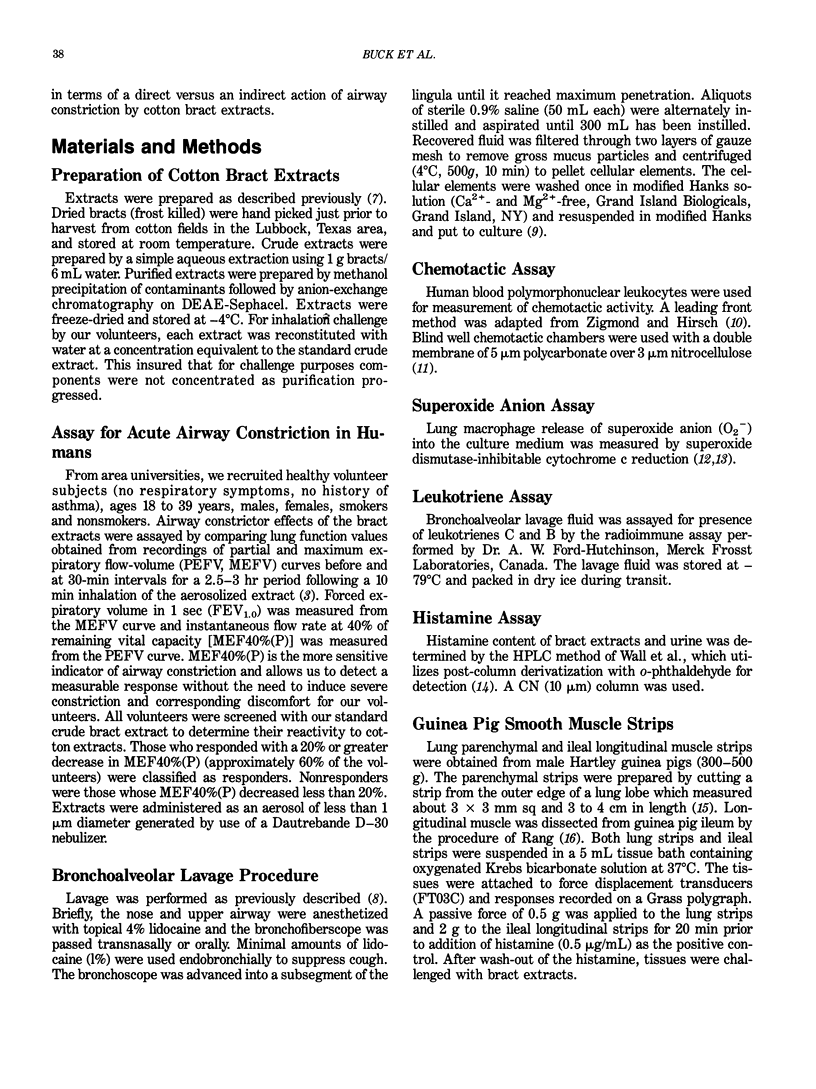
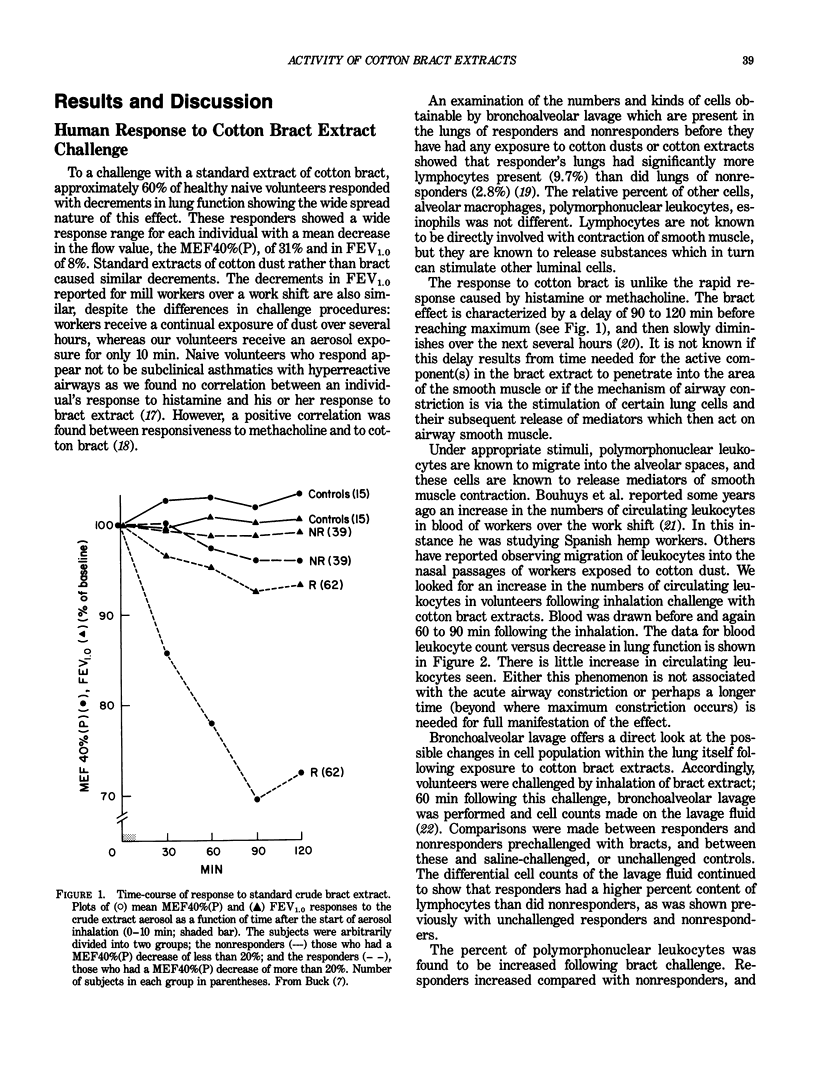
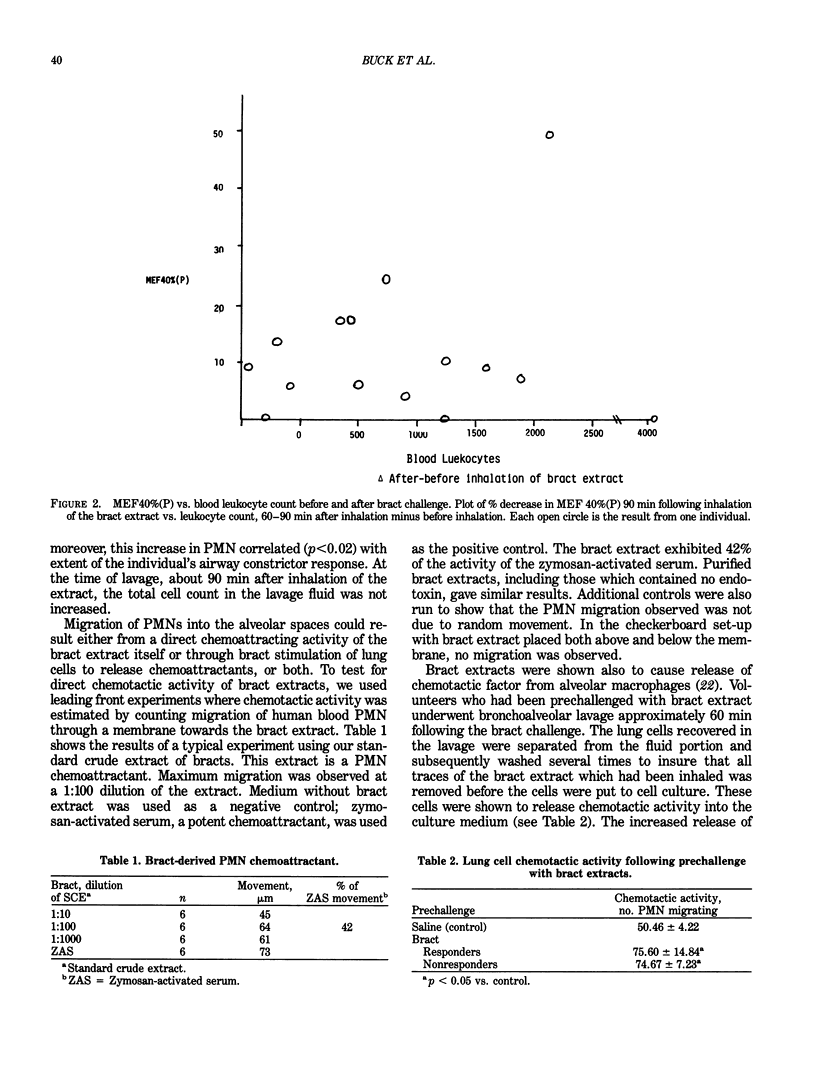


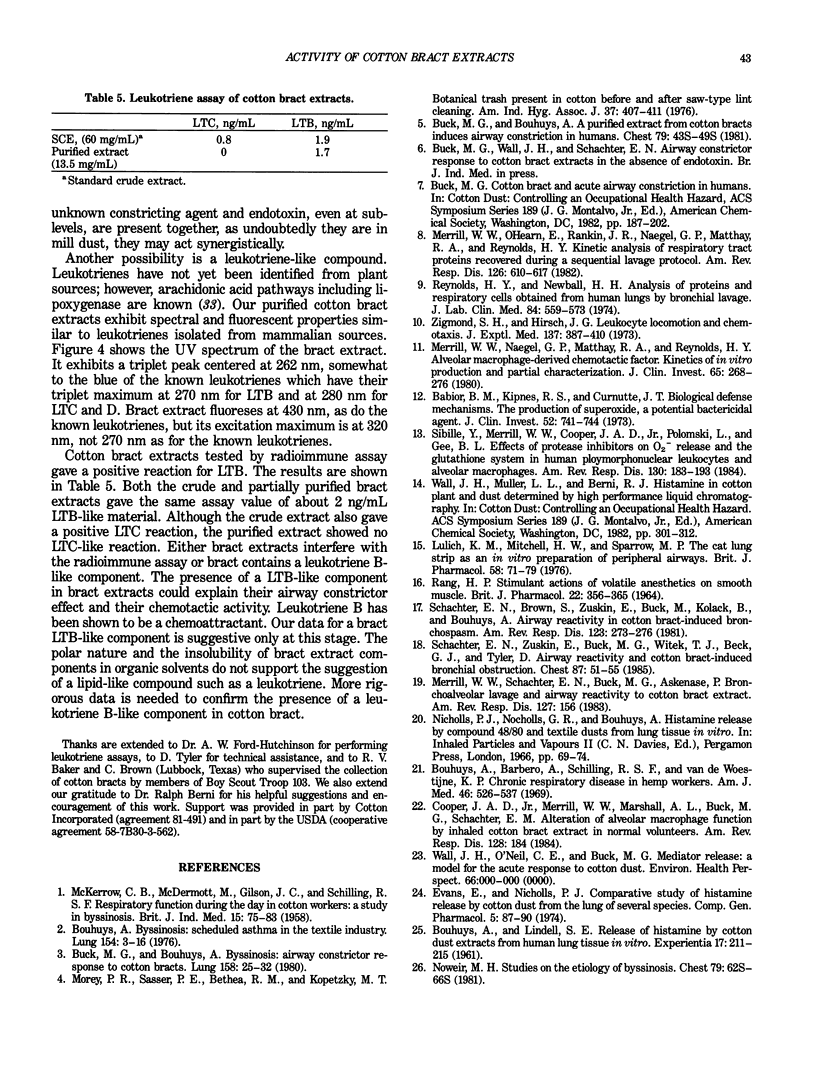
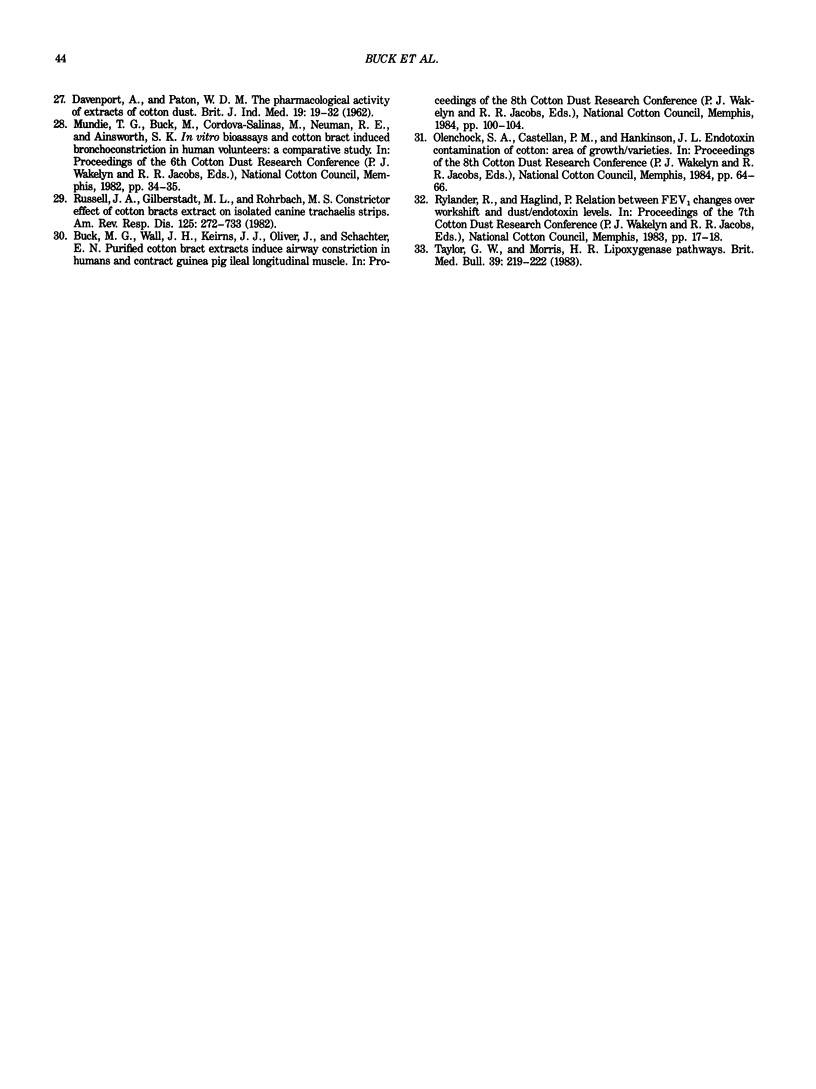
Selected References
These references are in PubMed. This may not be the complete list of references from this article.
- Babior B. M., Kipnes R. S., Curnutte J. T. Biological defense mechanisms. The production by leukocytes of superoxide, a potential bactericidal agent. J Clin Invest. 1973 Mar;52(3):741–744. doi: 10.1172/JCI107236. [DOI] [PMC free article] [PubMed] [Google Scholar]
- Bouhuys A., Barbero A., Schilling R. S., Van de Woestijne K. P. Chronic respiratory disease in hemp workers. Am J Med. 1969 Apr;46(4):526–537. doi: 10.1016/0002-9343(69)90072-2. [DOI] [PubMed] [Google Scholar]
- Bouhuys A. Byssinosis: scheduled asthma in the textile industry. Lung. 1976 Dec 29;154(1):3–16. doi: 10.1007/BF02713514. [DOI] [PubMed] [Google Scholar]
- Buck M. G., Bouhuys A. A purified extract from cotton bracts induces airway constriction in humans. Chest. 1981 Apr;79(4 Suppl):43S–49S. doi: 10.1378/chest.79.4_supplement.43s. [DOI] [PubMed] [Google Scholar]
- Buck M. G., Bouhuys A. Byssinosis: airway constrictor response to cotton bracts. Lung. 1980;158(1):25–32. doi: 10.1007/BF02713699. [DOI] [PubMed] [Google Scholar]
- Evans E., Nicholls P. J. Comparative study of histamine release by cotton dust from the lung of several species. Comp Gen Pharmacol. 1974 Mar;5(1):87–90. doi: 10.1016/s0306-3623(74)80012-1. [DOI] [PubMed] [Google Scholar]
- Lulich K. M., Mitchell H. W., Sparrow M. P. The cat lung strip as an in vitro preparation of peripheral airways: a comparison of beta-adrenoceptor agonists, autacoids and anaphylactic challenge on the lung strip and trachea. Br J Pharmacol. 1976 Sep;58(1):71–79. doi: 10.1111/j.1476-5381.1976.tb07694.x. [DOI] [PMC free article] [PubMed] [Google Scholar]
- McKERROW C. B., McDERMOTT M., GILSON J. C., SCHILLING R. S. Respiratory function during the day in cotton workers: a study in byssinosis. Br J Ind Med. 1958 Apr;15(2):75–83. doi: 10.1136/oem.15.2.75. [DOI] [PMC free article] [PubMed] [Google Scholar]
- Merrill W. W., Naegel G. P., Matthay R. A., Reynolds H. Y. Alveolar macrophage-derived chemotactic factor: kinetics of in vitro production and partial characterization. J Clin Invest. 1980 Feb;65(2):268–276. doi: 10.1172/JCI109668. [DOI] [PMC free article] [PubMed] [Google Scholar]
- Morey P. R., Sasser P. E., Bethea R. M., Kopetzky M. T. Variation in trash composition in raw cottons. Am Ind Hyg Assoc J. 1976 Jul;37(7):407–412. doi: 10.1080/0002889768507483. [DOI] [PubMed] [Google Scholar]
- Noweir M. H. Studies on the etiology of byssinosis. Chest. 1981 Apr;79(4 Suppl):62S–67S. doi: 10.1378/chest.79.4_supplement.62s. [DOI] [PubMed] [Google Scholar]
- RANG H. P. STIMULANT ACTIONS OF VOLATILE ANAESTHETICS ON SMOOTH MUSCLE. Br J Pharmacol Chemother. 1964 Apr;22:356–365. doi: 10.1111/j.1476-5381.1964.tb02040.x. [DOI] [PMC free article] [PubMed] [Google Scholar]
- Reynolds H. Y., Newball H. H. Analysis of proteins and respiratory cells obtained from human lungs by bronchial lavage. J Lab Clin Med. 1974 Oct;84(4):559–573. [PubMed] [Google Scholar]
- Russell J. A., Gilberstadt M. L., Rohrbach M. S. Constrictor effect of cotton bract extract on isolated canine airways. Am Rev Respir Dis. 1982 Jun;125(6):727–733. doi: 10.1164/arrd.1982.125.6.727. [DOI] [PubMed] [Google Scholar]
- Santiago T. V., Sheft S. A., Khan A. U., Edelman N. H. Effect of naloxone on the respiratory responses to hypoxia in chronic obstructive pulmonary disease. Am Rev Respir Dis. 1984 Aug;130(2):183–186. doi: 10.1164/arrd.1984.130.2.183. [DOI] [PubMed] [Google Scholar]
- Schachter E. N., Brown S., Zuskin E., Buck M., Kolack B., Bouhuys A. Airway reactivity in cotton bract-induced bronchospasm. Am Rev Respir Dis. 1981 Mar;123(3):273–276. doi: 10.1164/arrd.1981.123.3.273. [DOI] [PubMed] [Google Scholar]
- Schachter E. N., Zuskin E., Buck M. G., Witek T. J., Beck G. J., Tyler D. Airway reactivity and cotton bract-induced bronchial obstruction. Chest. 1985 Jan;87(1):51–55. doi: 10.1378/chest.87.1.51. [DOI] [PubMed] [Google Scholar]
- Taylor G. W., Morris H. R. Lipoxygenase pathways. Br Med Bull. 1983 Jul;39(3):219–222. doi: 10.1093/oxfordjournals.bmb.a071822. [DOI] [PubMed] [Google Scholar]
- Zigmond S. H., Hirsch J. G. Leukocyte locomotion and chemotaxis. New methods for evaluation, and demonstration of a cell-derived chemotactic factor. J Exp Med. 1973 Feb 1;137(2):387–410. doi: 10.1084/jem.137.2.387. [DOI] [PMC free article] [PubMed] [Google Scholar]


